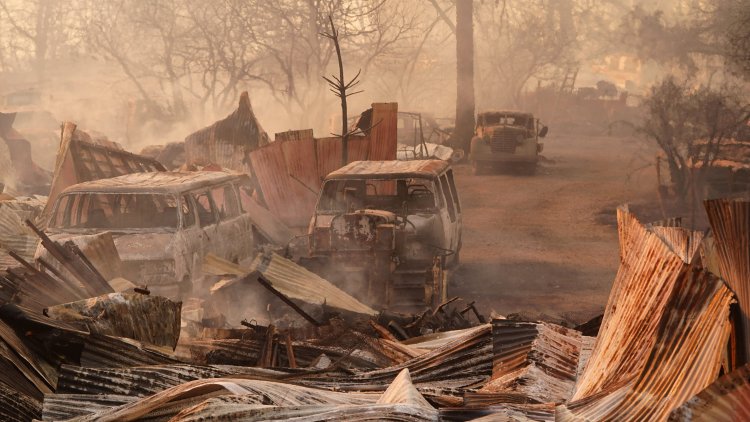California’s Fire Luck Just Ran Out
The Park Fire is already one of the 10 largest recorded in the state’s history.

For two years, the fire gods cut California a break. The winter rains came down heavy, and brought the state’s yearslong drought to an end. Plants started growing again. Grasses were green. The poppies bloomed larger than normal. For awhile, living here meant seeing the place’s better nature—going outside and exploring the mountains and lakes and vineyards, without thinking of breathing in toxic smoke plumes. The apocalyptic scenes of 2020 and 2021 receded like a bad dream; any worries about fire were a problem of the past, or the future.
Then the heat came, and the green faded. Plants died. People who know where to look started to see the warning signs. Now when David Acuna, a battalion chief at Cal Fire, walks around his local area, he sees layers of grass: standing grass, but also the remnants of previous years’ grasses. “They are just waiting to burn,” he told me yesterday. Wildfire is cyclical, and wet years can set up future ones for worse fires. Even when the landscape is lush and healthy, California is operating on borrowed time.
This week, fire came roaring back. California’s first major fire in three years is burning. The Park Fire, located near the city of Chico in Northern California, started Wednesday and grew quickly, tripling in size in a single day. By this morning, the blaze, which started when a man allegedly rolled a burning car into a gully, had spread across more than 300,000 acres, and was zero percent contained. Already it is one of the 10 largest recorded fires in California history, and it is moving extremely fast. “We had our fire grow by 120,000 acres in a single day,” Acuna said. “That is not normal.”
Fire is a natural part of California’s ecosystem, and can help clear space for new plant life. But in the past 10 years, the combination of dry fuels, hot temperatures, and winds have made for more explosive fire growth, according to Dan Macon, a UC Cooperative Extension livestock and natural-resources adviser who monitors the grass conditions in the area just south of where the Park Fire is. “When I was a kid, a big fire was 5,000 acres,” he told me. Abnormally hot weather, in particular, may be helping feed bigger and more violent fires. One paper tried to isolate the role of climate change in California’s wildfires over the past 50 years, and found that human-caused warming was responsible for almost all of the increase in acreage burnt.
Those exact dynamics seem to be driving the current fire. California’s two consecutive wet springs, in 2023 and 2024, left the state with a lot of extra vegetation—or, as wildfire experts call it, fuel. Extreme heat early this summer dried all that fuel out: One heat wave around the Fourth of July drove temperatures up to, or past, 110 degrees in parts of the state. Conditions are bad right now, and fire activity has picked up accordingly. The state’s five-year average for acres burned by this time of year is about 117,000 acres, Acuna said. This year, some 467,000 acres, more than three times what’s normal, have already been scorched. Matthew Shameson, a meteorologist at the U.S. Forest Service, told me he and his colleagues expect above-average fire activity to continue for much of the state through September.
None of that means that this particular fire, at this particular time, was inevitable. Last year could’ve been a bad one—Acuna, with Cal Fire, told me he’d braced for that—but it ended up being relatively quiet. California got lucky. And even the biggest fires can start by chance: The majority of wildfires in the U.S. are caused by humans, as is the case with the Park Fire, though in many cases the spark is less dramatic—a runaway camp fire or a misplaced cigarette butt. (The man who allegedly started this blaze is under arrest.) The second biggest cause is lightning.
The odds that California—and the rest of the West—get any lucky breaks this year seem low. It’s only July. National firefighting resources are already strained, and “we’ve still got a lot of dry, hot weather ahead of us,” Macon pointed out. People living in the West know to expect fire, even if we try to forget it during green seasons and years of reprieve. But the breaks always end. The Park Fire is eerily close to the site of the Camp Fire, which killed 85 people in 2018. Parts of Paradise, a town that’s still recovering from that fire, are under evacuation warning.
Just this week, two other fires burned through Canada’s Jasper National Park, where people flock to bathe in impressive forests and cliffsides, to feel humbled by the marvels around them. Living in this part of the world means living amid beauty. And it means forever waiting for the moment when all that beauty goes up in smoke.
What's Your Reaction?




















